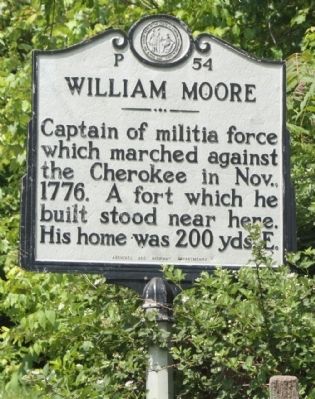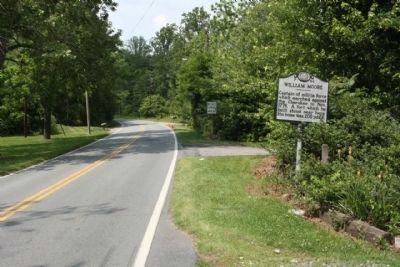Enka Village in Buncombe County, North Carolina — The American South (South Atlantic)
William Moore
Erected 1960 by Archives and Highway Departments. (Marker Number P-54.)
Topics and series. This historical marker is listed in this topic list: Wars, US Indian. In addition, it is included in the North Carolina Division of Archives and History series list. A significant historical year for this entry is 1776.
Location. 35° 32.796′ N, 82° 38.025′ W. Marker is in Enka Village, North Carolina, in Buncombe County. Marker is on Sand Hill Road (Route 3412), on the left when traveling south. Touch for map. Marker is in this post office area: Asheville NC 28806, United States of America. Touch for directions.
Other nearby markers. At least 8 other markers are within 4 miles of this marker, measured as the crow flies. Home Place of Capt. Wm. Moore (about 300 feet away, measured in a direct line); Sulphur Springs (approx. 1.9 miles away); Rutherford Trace (approx. 2 miles away); a different marker also named Rutherford Trace (approx. 2 miles away); Olive Tilford Dargan (approx. 3 miles away); "End of Car Line" (approx. 3.2 miles away); Dr. L.B. McBrayer (approx. 3.4 miles away); The Quilt Garden (approx. 3.7 miles away).
More about this marker. House is not visible from the roadway
Regarding William Moore. William Moore was born in Ireland and became one of the first white settlers west of the Blue Ridge in what is known as Buncombe County. Moore’s first visit to the area came in the fall of 1776 when he served as a militia captain under the command of General Griffith Rutherford. Rutherford’s expedition into western sections of North Carolina was designed to stop conflicts between the native Cherokee and encroaching white settlers. Additionally, they wanted to put a stop to the practices of British recruiters who enlisted the help of the Cherokee in harassing colonists during the early stages of the Revolutionary War.
Moore wrote a detailed account of an expedition of mounted troops that he led through the region. In his account, Moore described destruction of Indian towns and villages plus the brutal murder and mutilation of natives who were fleeing his men. Moore was at odds with his men over the care of Indian prisoners. Upon threat of mutiny, Moore was reluctantly obliged to sell some of their prisoners into slavery and divide the bounty among his men.
Moore returned to western North Carolina after Rutherford’s expedition and settled on land along Hominy Creek. Moore and second wife, Margaret Patton, raised his six children from his first marriage
to Ann Cathey as well as their six children. Moore served during the Revolution and then returned to Buncombe to serve in municipal and civic roles the remainder of his life. It is said that Moore first constructed a block fort on his property near Hominy Creek for protection from Native Americans.(North Carolina Dept. of Cultural Resources)
Also see . . . The Rutherford Expedition- the North Carolina Office of Archives and History. ...Cherokees demanded the withdrawal of settlers from the western settlements within twenty days and made plans for an attack. ... (Submitted on July 5, 2012, by Mike Stroud of Bluffton, South Carolina.)
Credits. This page was last revised on June 22, 2021. It was originally submitted on July 5, 2012, by Mike Stroud of Bluffton, South Carolina. This page has been viewed 1,056 times since then and 66 times this year. Photos: 1, 2, 3. submitted on July 5, 2012, by Mike Stroud of Bluffton, South Carolina.


